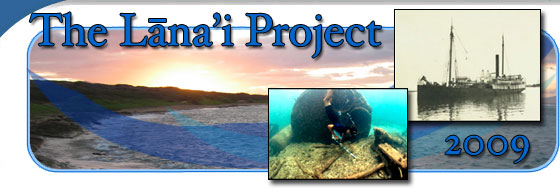Project History
The 2009 survey project adds to an existing effort to understand and appreciate historic resources on Lāna`i’s north shore.
The Hawaiian archipelago, through its long history of intensive maritime activity, has witnessed the loss of literally hundreds of 19th and early 20th century ships. Specific sources, such as Mifflin Thomas’s books Schooner from Windward and Hawaiian Registered Vessels, as well as Reverend Thrum’s Hawaiian Annual and Standard Guide and William King’s Pictorial Maritime History of Hawai`i and articles in the Pacific Commercial Advertiser (today’s Honolulu Advertiser), contain much information on the final disposition of many of these ships, making possible an initial list of known shipwrecks for Lāna`i.
Known losses include: British ship Alderman Wood (lost 1824); American ship London (lost 1826); Hawaiian schooner Onward (lost 1875); Hawaiian schooner Mary Alice (lost 1884); Hawaiian schooner Malolo (lost 1887); Hawaiian schooner Golden Gate (lost 1901); Hawaiian steamship Hornet (disposed 1927); Hawaiian schooner Helene (disposed 1929); Hawaiian vessel Manukiiwai (abandoned 1929); private yawl Charlotte C (lost 1931); private auxiliary Tradewind (lost 1934); three US Navy steel LCM landing craft (lost 1940’s); Hawaiian barge Oregon Reefer (disposed 1954); US Navy oiler YO-21 (disposed 1957?); US Navy fuel barge YOGN-42 (disposed 1960?).
The academic survey of maritime heritage resources at Shipwreck Beach began in 1999 with a preliminary reconnaissance by a small team from the University of Hawai`i at Mānoa, building on previous work by local researchers. This reconnaissance led to a university field school in 2001. The effort was initiated as a pre-disturbance or non-excavation survey; the in situ preservation approach being compatible with the emerging UNESCO international standards for maritime archaeology. Over time, information has continued to be compiled which contributes to a more comprehensive picture of this maritime cultural landscape.
The 2001 University of Hawai`i Field School
 |
|
The bow of the grounded navy yard oiler YO-21. (J Kuwabara, University of Hawai`i Marine Option Program)
|
The 2001 project, “Lāna`i Island Shipwreck Beach Maritime Cultural Resource Survey,” was part of the University of Hawai`i’s Graduate Maritime Archaeology and History certificate program, supported by the Marine Option Program. Ten students were trained in maritime archaeology surveying methods, and the field team then spent ten days camped at Awalua Bay, Lāna`i, investigating two wreck sites in the ocean and one ship’s timber concentration on shore.
 |
|
United States Navy auxiliary oiler YO-21 at Pearl Harbor, date unknown. (Bishop Museum)
|
The YO-21 was a navy yard oiler, a 160-foot single-screw steel tanker with a triple expansion steam engine. According to oral reports, the vessel was intentionally grounded by the military sometime in the 1950’s. YO-21 was built in Newburgh, New York by the Tank Shipbuilding Co. in 1918 and subsequently purchased by the US Navy. She was available for service by 1924 and assigned to the 14th Naval District at Pearl Harbor. According to Terence McComas’s Pearl Harbor: Fact and Reference Book, YO-21 was present during the attack, making her the fourth known Pearl Harbor vessel still in Hawaiian waters. By August 22nd 1946 the YO-21 had been judged surplus to navy needs and placed out of service. She was stricken from the Naval Register on December 30th of that year, and was turned over to the Naval Supply Center for salvage on July 30th 1947. Historic photographs, located by Captain Rick Rogers, matched the construction details of the hulk at Awalua, confirming the probable identification.
 |
|
Boiler face and engine debris at the Awalua steamship wreck site. (J Kuwabara, University of Hawai`i Marine Option Program)
|
The second site studied in 2001 was a wreck of a wooden-hulled steamship with a single boiler, double-compound steam engine. Equipment and debris lay scattered from the beach to over 500 feet off shore. The lack of salvageable equipment, and the complete lack of anchors or anchor chain, indicated that the vessel was likely intentionally grounded. The engine cylinder dimensions roughly matched those for the SS Hornet, a 697-ton steamer built by Lindstrom Shipbuilding Company in Aberdeen, Washington, in 1906. No specific details on the encrusted submerged machinery could be made out, though, so the Hornet remained only a possible (not probable) identification. Additional research since 2001revealed a closer match to the specifications of the SS Mikahala (see Results).
2009 NOAA and UH Heritage Resource Survey
 |
|
Double expansion steam engine on its side, near Awalua. (J Kuwabara, University of Hawai`i Marine Option Program)
|
The 2009 project, “Return to Shipwreck Beach: a coastal resources awareness project,” combined a plan for a maritime archaeology field course with added emphasis on multiple cultural perspectives and local community participation. The project proposal was submitted to NOAA’s Preserve America Initiative Grant (PAIG) program in February, 2009. The award was granted in April, and subsequently a short reconnaissance trip was made in order to assess potential survey sites in terms of safe access, ocean conditions, etc. During that three-day trip the steamship wreck site at location LAN-011 (Lāna`i maritime site #11) near Lae Wahie was selected as the primary study area, and arrangements were made to allow the research team to stay at Federation Camp.
 |
|
Sabina Van Tilburg, field survey and cooking assistant, on the wreck site during the 2009 reconnaissance trip. (H Van Tilburg/NOAA ONMS)
|
Certain facts about the wreck site were confirmed prior to the start of the field survey. The wreck site represented a single-screw, wooden-hulled double-compound engine steamship with a cylindrical Scotch boiler. The lack of salvageable equipment, and the complete lack of anchors or anchor chain trail, indicated that the ship or hulk was likely intentionally grounded, as was common among past steamship owners. This information allowed the students to create a short list of possible steamers which: 1) matched the engine specifications, and: 2) may have been disposed on Shipwreck Beach (see Results).
|



